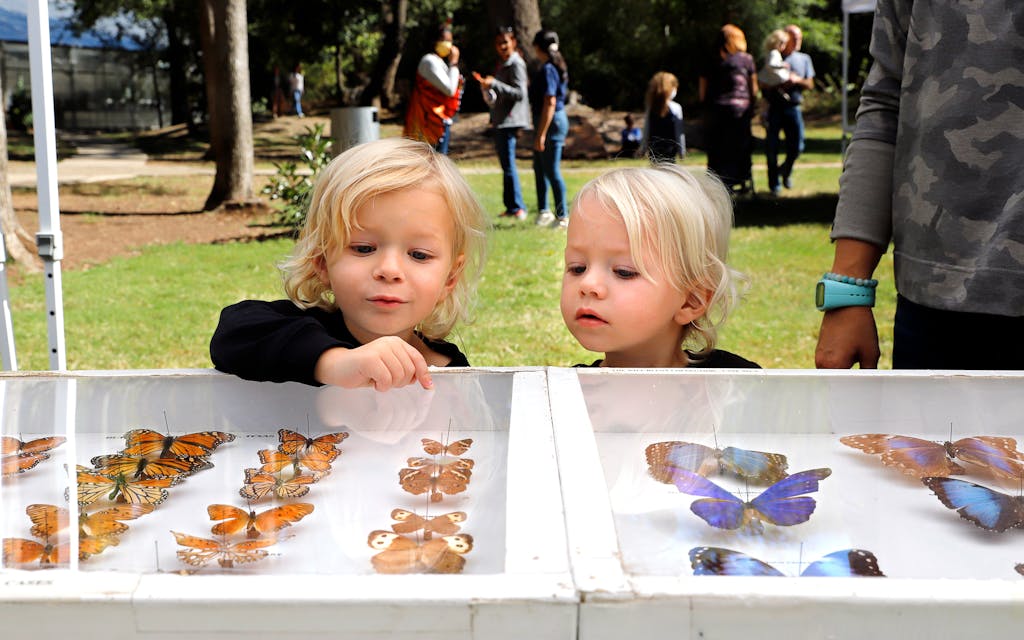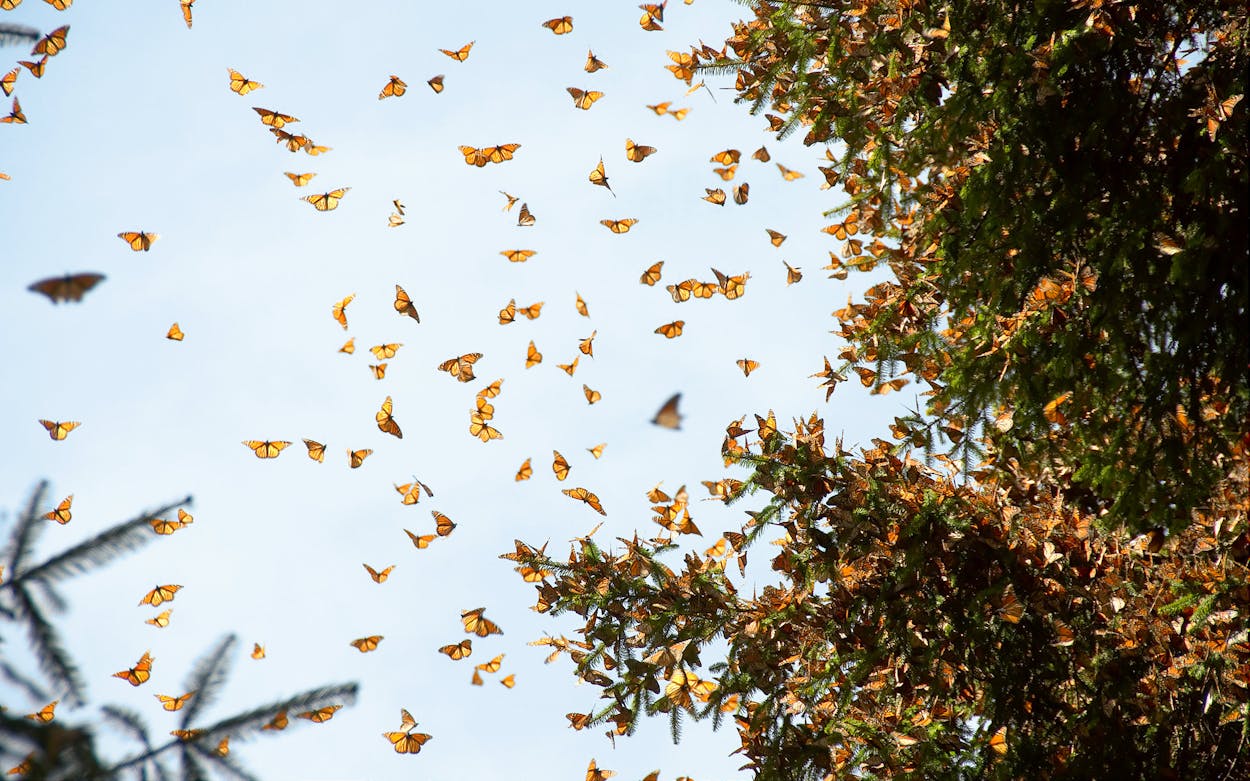Armed with a small trowel, I leaned over on my hands and knees on a hot evening in August and carefully tried to rescue our fledgling butterfly garden. Aggressive ivy had wrapped around the little green milkweed stalks my wife and I had tried to protect, so I dug up each plant, placing it in a new pot with fresh compost and a light covering of mulch. I knew that all our hopes of having a healthy habitat for the native insects depended on the health of these plants.
I’ve always had a soft spot for backyard wildlife. As a kid growing up in the Fort Worth suburb of Grapevine, I learned from my parents how to plant a native garden and remove invasive plants. We even attended our town’s annual monarch butterfly festival, the charmingly named Butterfly Flutterby. When I bought my own home in Arlington, I wanted to find ways to provide habitat and protection for the official state insect. The most obvious way to do that is to plant milkweed, which my wife and I did this spring. After it was crowded out by invasive English ivy, we moved the plants into terra-cotta pots on our patio.
We weren’t expecting any caterpillars until the native milkweed plant started blooming in a few years, but I knew its presence was critical to helping monarchs on their biannual migrations through Texas to and from Mexico. So one evening in early September, I was thrilled to spot something small with white, black, and yellow stripes crawling along a leaf on the larger of the three plants: a monarch caterpillar.
I leaned down to take a photo and spotted another. Two caterpillars! I named them Pancho and Lefty, after the Townes Van Zandt song, and moved them into a mesh butterfly cage. I checked on them several times a day, cleaning their frass—little green caterpillar poops—and hoping to see them attach to the wall of cage and begin forming their pupae, or chrysalises.
It was a difficult proposition, I knew. I didn’t realize how much of an uphill battle it can be to protect something so fragile as an inch-long caterpillar.
Every spring and every fall, backyards across Texas are a rest stop for one of nature’s greatest migrations. Thousands of monarch butterflies with bright orange and black patterned wings travel the “monarch highway” of Interstate 35 to and from the mountains of Michoacán, Mexico. This path is one of two main routes, or flyways, that the insects follow through Texas on their long journey south, which takes place throughout October and into November. They also traverse the Gulf Coast a few weeks later than those taking the central flyway. In March and April they head north toward Canada.
But natural predators, non-native species, pesticides, habitat destruction from human development, and a changing climate all threaten that migration pattern. Scientists estimate monarch butterfly populations by measuring the acreage the bugs occupy each winter, and that number dropped by 53 percent from 2019 to 2020.
That’s a worrying sign, even though monarchs are not yet on the endangered species list. If the monarch migration continues to dwindle, we’ll lose a connective tissue between three nations—Mexico, the United States, and Canada—that ties the continent together, says Marianna Treviño-Wright, executive director of the National Butterfly Center in Mission.
“It unites all of us,” Treviño-Wright says. “You can hardly talk to anyone who hasn’t seen a monarch and enjoyed their majesty.”
Raising butterflies starts with raising native plants in the garden. Milkweed is just one piece of this puzzle. Butterflies need a combination of nectar plants for adults and host plants for caterpillars to munch on in any backyard habitat. That means growing flowering plants like goldenrod, autumn sage, Texas lantana, or varieties of mistflower or aster.
“Primarily you want to plant natives because they evolved with the monarchs through the challenges of the Texas climate,” says Daniel Cunningham, a North Texas horticulturist and co-owner of Rooted In, an environmental consulting firm.
But without milkweed, the monarch’s life cycle is in danger, and finding and growing the native plant is easier said than done. Tropical, non-native milkweed is plentiful in Texas garden shops. It grows quickly and blooms late into the year, which can cause problems for monarchs. If the non-native plant is blooming when winter arrives, monarchs may stick around and freeze, rather than migrating south with their kin.
One day, I noticed Lefty wasn’t growing and had begun to shrivel. A few hours later, it was clear he was gone. All that hard work to keep him safe, and it looked like he’d been attacked by an infection or parasite—common for caterpillars, I’ve since learned. To my dismay, Pancho also met an unfortunate end: he was eaten by fire ants just before his big transformation.
I told this story to Sam Kieschnick, a Texas Parks and Wildlife biologist based in Dallas–Fort Worth. He said protecting the lives of my monarch caterpillars meant keeping a meal from other creatures. Watching Pancho die was horrifying, but those fire ants had to eat, too, Kieschnick says.
“There is warfare, constant warfare, to exist in all cases,” says Kieschnick. “Nature is always struggling for existence, and we get to experience this in our little gardens as we try to enjoy butterflies.”
When I called her to ask what I could’ve done differently in my own backyard, Treviño-Wright at the National Butterfly Center said that some people take monarch fever to extremes. There are online communities of “monarch mommies” who raise hundreds each year, care for caterpillars as though they’re pets, and scour the internet for more milkweed and bigger cages. It’s a rabbit hole I could’ve fallen into with Pancho and Lefty.
“We think we’re helping the species, but as with all things human beings do, we’re probably doing more harm,” Treviño-Wright cautions.
But others, including Cunningham, the horticulturist, argue that captive monarch caterpillars can be a powerful educational tool. “Raising cats,” as he calls it, can teach children about the importance of caring for natural habitats. “To actually have a monarch that forms its chrysalis and emerges inside your home is an incredible way to get people involved,” he says. “You have successes and failures, but in the end you have a greater interest in protecting this species that is so iconically Texan.”
Kieschnick agrees. He adds that planting milkweed and other wildflowers not only makes your garden more attractive to monarchs, it also welcomes other wildlife. “We have an opportunity to use our flower beds as a refuge,” he says.
Those refuges are increasingly important to keep monarchs in Texas. The species isn’t listed as endangered or threatened, but researchers and fans are still concerned about its decline. In 1996, there were 384 million monarchs wintering in Mexico. The U.S. Fish and Wildlife Service estimates that just 60 million made it back there in 2019. Treviño-Wright said the worry isn’t so much that the entire species could go extinct, but that the iconic migration could end if habitat destruction continues in places like Texas.
Some advocates hope that monarchs will eventually be added to the endangered species list, but this is controversial. Such a designation would make it illegal to breed monarchs or to release them en masse, as currently happens at the Grapevine festival.

After Pancho and Lefty died, I decided to stop by the Butterfly Flutterby to see how the event had changed since the small festival I remember from the late nineties. Jenny Singleton, who calls herself a butterfly wrangler, has worked for the festival since it started 24 years ago. She says there are far fewer monarchs today than when she began.
“Back then, there were lots of butterflies,” Singleton says. “They don’t know where they’re going, but I swear they go up to our yard. It’s like they know they should be there.”
The main event, the one I remember most from my childhood and the one Singleton had carefully prepared for, was the butterfly release. Singleton and a few volunteers had already tucked hundreds of butterflies into individual waxed-paper envelopes—entomologists say butterflies don’t feel pain, and the envelopes, amazingly, don’t injure the paper-thin creatures. Families lined up, hoping to get one of 250 butterflies for the first release of the morning. Jenny handed them carefully to each child until the supply ran out. Someone with a microphone started the countdown. Five, four, three, two, one . . .
One at a time, little spots of orange floated up over the crowd. Soon they were all around, landing on children’s shoulders and outstretched hands. For a half hour, the butterflies lingered, almost like they wanted to show off their colors for the crowd. Singleton watched them all with a slight smile. She adjusted her hair behind pewter butterfly earrings.
“It’s pretty cool, isn’t it?” she asked. “They’re going to remember this for the rest of their lives.”
“I did,” I told her, thinking about my own visit to the festival as a child.
I’d already told her about Pancho and Lefty, and as I turned to say goodbye she reached into a bag and handed me two small envelopes—two butterflies to bring back to Arlington. Later that day, my wife and I stood in the backyard, not far from where we’d kept our caterpillars, and had our own countdown. Three, two, one . . .
The two bright orange butterflies launched out of their envelopes. I watched them float up into the sky, not stopping on our little milkweed plants. Before long they were already on their long journey ahead, away toward Mexico.
Five Tips for Raising Monarchs in Your Backyard
Plant native. Native plants help provide food and shelter for native animals. They often don’t need as much water and are adapted for your local climate. For monarchs in particular, native milkweed is crucial, and three species—green milkweed, antelope-horns milkweed, and zizotes milkweed—are best in Texas. If you plant a non-native species, like tropical milkweed, make sure to cut it back each fall so migratory species know it is time to move south. Ask staff at your local garden center which milkweed species they’re selling, or use this handy identification guide.
Plant diverse. Butterflies need both nectar and host plants. If your flower bed is diverse, you’ll attract other critters too, like songbirds, moths, and bees. Need ideas for what to plant in your neck of the woods? We’ve got them here.
Make sure caterpillars have plenty of food and a clean space. Some experts say that once you have created a healthy ecosystem, it’s best to leave it alone and let nature take its course. If you decide to move caterpillars into a cage, make sure you’re cleaning the droppings daily and providing plenty of milkweed for them to eat.
Be ready to lose some caterpillars. Part of enjoying nature means accepting death as a part of the circle of life. It’s natural for caterpillars to be eaten by predators or be killed by parasites. Only a small percentage will become butterflies and eventually give birth to the next generation.
Let them fly free. Check on your caterpillar daily, especially if it has gone into its pupa or chrysalis. When it emerges as a butterfly, be ready to let it fly free. The point of raising these insects is to let them go so they can pollinate your garden and produce more caterpillars.
- More About:
- Critters
- Grapevine
- Fort Worth
- Arlington






